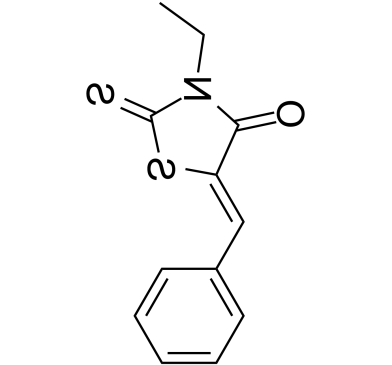Physicochemical Properties
| Molecular Formula | C12H11NOS2 |
| Molecular Weight | 249.35184 |
| Exact Mass | 249.028 |
| Elemental Analysis | C, 57.80; H, 4.45; N, 5.62; O, 6.42; S, 25.72 |
| CAS # | 18331-34-5 |
| Related CAS # | 18331-34-5 |
| PubChem CID | 2244563 |
| Appearance | Solid |
| Density | 1.34g/cm3 |
| Boiling Point | 372.8ºC at 760mmHg |
| Flash Point | 179.3ºC |
| Vapour Pressure | 9.34E-06mmHg at 25°C |
| Index of Refraction | 1.692 |
| LogP | 2.845 |
| Hydrogen Bond Donor Count | 0 |
| Hydrogen Bond Acceptor Count | 3 |
| Rotatable Bond Count | 2 |
| Heavy Atom Count | 16 |
| Complexity | 332 |
| Defined Atom Stereocenter Count | 0 |
| SMILES | C(N1C(=O)/C(=C\C2C=CC=CC=2)/SC1=S)C |
| InChi Key | ZQDPYAPUFMILTB-UHFFFAOYSA-N |
| InChi Code | InChI=1S/C12H11NOS2/c1-2-13-11(14)10(16-12(13)15)8-9-6-4-3-5-7-9/h3-8H,2H2,1H3 |
| Chemical Name | 5-benzylidene-3-ethyl-2-sulfanylidene-1,3-thiazolidin-4-one |
| Synonyms | BTR-1 |
| HS Tariff Code | 2934.99.9001 |
| Storage |
Powder-20°C 3 years 4°C 2 years In solvent -80°C 6 months -20°C 1 month |
| Shipping Condition | Room temperature (This product is stable at ambient temperature for a few days during ordinary shipping and time spent in Customs) |
Biological Activity
| Targets | Apoptosis |
| ln Vitro | BTR-1 (10, 50, 100, and 250 µM, 5 days) causes cytotoxicity in human leukemic cells, with IC50s of 8 and 6 µM at 48 and 72 h, respectively[1]. |
| References |
[1]. Novel rhodanine derivatives induce growth inhibition followed by apoptosis. Bioorg Med Chem Lett. 2010 Nov 1;20(21):6297-301. |
Solubility Data
| Solubility (In Vitro) | DMSO: 13~25 mg/mL (52.1~100.26 mM) |
| Solubility (In Vivo) |
Solubility in Formulation 1: ≥ 2.08 mg/mL (8.34 mM) (saturation unknown) in 10% DMSO + 40% PEG300 + 5% Tween80 + 45% Saline (add these co-solvents sequentially from left to right, and one by one), clear solution. For example, if 1 mL of working solution is to be prepared, you can add 100 μL of 20.8 mg/mL clear DMSO stock solution to 400 μL PEG300 and mix evenly; then add 50 μL Tween-80 to the above solution and mix evenly; then add 450 μL normal saline to adjust the volume to 1 mL. Preparation of saline: Dissolve 0.9 g of sodium chloride in 100 mL ddH₂ O to obtain a clear solution. Solubility in Formulation 2: ≥ 2.08 mg/mL (8.34 mM) (saturation unknown) in 10% DMSO + 90% Corn Oil (add these co-solvents sequentially from left to right, and one by one), clear solution. For example, if 1 mL of working solution is to be prepared, you can add 100 μL of 20.8 mg/mL clear DMSO stock solution to 900 μL of corn oil and mix evenly. (Please use freshly prepared in vivo formulations for optimal results.) |
| Preparing Stock Solutions | 1 mg | 5 mg | 10 mg | |
| 1 mM | 4.0104 mL | 20.0521 mL | 40.1043 mL | |
| 5 mM | 0.8021 mL | 4.0104 mL | 8.0209 mL | |
| 10 mM | 0.4010 mL | 2.0052 mL | 4.0104 mL |
